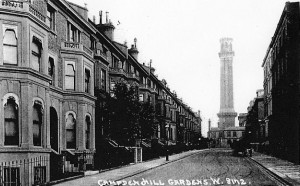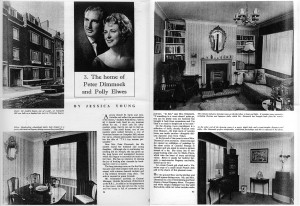“You have to give this much to the Luftwaffe: when it knocked down our buildings it did not replace them with anything more offensive than rubble. We did that.”
Prince Charles, Prince of Wales, 2 December 1987

Earlier this week in the local studies section of my public library I found this photograph taken in 1905 of the street in which I currently live. Note the complete absence of automobiles and the tall chimney at the end of the road, part of an engine house that was destroyed in the 1970s. I live on the right hand side of the street, about half way up towards the chimney.
Some months ago just out of curiosity I searched for the street on Google, and I found a memoir written by Elizabeth Anne Slusser née Burbury (1915-1991), who lived in the house next door to mine from 1915 to 1939. Elizabeth Slusser appears to have had an interesting life. She was born in London to a wealthy and well connected family. In her memoir she describes annual holidays to Brittany and the year she spent learning Italian in a Catholic convent in Florence when she was just seven. She describes her home in London a little, and mentions her subsequently famous neighbours several times (Dame Marie Rambert and her husband, the theatre impresario Ashley Dukes, lived just across the street).
[Elizabeth’s parents met in Tasmania, but moved to England soon after marrying. Once settled in London her mother, Daisy Burbury née Guesdon, “founded a literary salon at 32 Campden Hill, Notting Hill Gate, which was frequently visited by Hilaire Belloc, G.K. Chesterton, Maurice Baring and others. There is a statue of her in the House of Commons as the Virgin Mary, with her daughter Norah as the infant Jesus.”]
Elizabeth’s memoir comes to an abrupt end in August 1939, but not before she mentions that her family’s home was one of the first in London to be destroyed by a German bomb in 1940. I can vouch for this fact because I now live next door to the four new homes that were subsequently built on the bombed site in 1955/56.
These four homes are all contained in what must be the single most ugly building on the street. In typical post-war fashion, the developers allowed function to completely overwhelm form, but then they compromised the functionality by squeezing far too many features into the limited available space. Each of the four houses was provided with a small covered car port, which cannibalised a significant portion of the ground floor and yet can only be used for the smallest of contemporary automobiles. In an effort to save costs, cheap and ugly materials were used to construct the building. Even the window boxes, which can probably withstand an earthquake, are made of cement and permanently affixed to the exterior walls with steel rods. What was the architect thinking?
Imagine my surprise then when during my visit to the library, I also discovered a 1962 article from Homes and Gardens magazine featuring the house next door. Apparently, it was the home of two television celebrities, Peter Dimmock and his wife Polly Elwes. He was a presenter on the BBC’s flagship sports programme Sportsview, while his wife presented a current affairs programme called Tonight.

As you can see from the accompanying image (caution, it’s a long download at 644Kb), the article was illustrated with several images which give you a good idea of how it was furnished and a sense of what it must have been like to live there in the early 1960s. Ironically, Mrs. Dimmock is quoted as saying:
“A home should be warm and comfortable and reflect the personalities of its owners; above all it should look lived in – no museum effects for me. I don’t care for ultra-modern styles, they’re too apt to feel unfriendly.”
Well that might all be true, but did you look at the place from across the street before you moved in? Warm and comfortable? I don’t think so. More like sterile and frightening.
I don’t know when Mr. and Mrs. Dimmock moved out, but the house was sold late last year and in February workmen began to knock down all the internal walls and rebuild the insides from scratch. I wonder if the finished home will be “warm and comfortable” or more in keeping with its “ultra-modern” exterior?
I can’t wait for the new owner to move in next month, so I can recommend the local library.